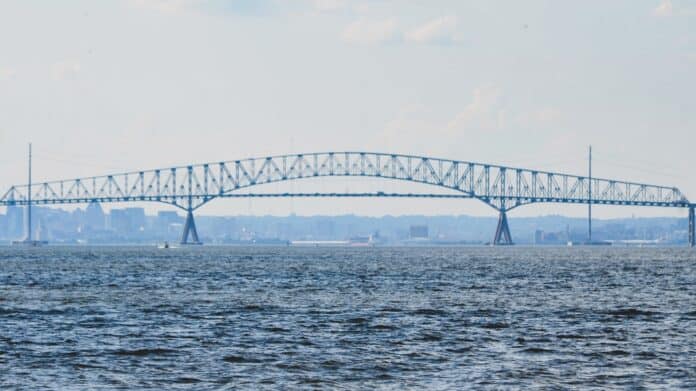The fragility of our infrastructure is in the news again this week with Baltimore’s Francis Scott Key Bridge collapse.
It throws another spotlight on the fragile nature of the global supply chain which has already been strained by several incidences including the drought in Panama and missile attacks by Houthi militants in the Red Sea. On early Tuesday morning, March 24th, the container ship Dali left the Port of Baltimore and was bound for Sri Lanka. The vessel departed Baltimore’s Dundalk Marine Terminal and began its journey up the Patapsco River and towards the Francis Scott Key Bridge. The vessel lost power close to 1:30 AM and the vessel drifted into the bridge’s main center support columns, impacting them, and causing the bridge to collapse, closing the port for the foreseeable future.
The Port of Baltimore handles about three percent of all U.S. East Coast and Gulf Coast imports according to S&P Global Market Intelligence.
Baltimore is the 17th biggest port by total tons. However, it ranks first in the nation by volume for the automobiles and light trucks it handles. In 2023, 750,000 vehicles were handled through the Port of Baltimore. It ranks first in the U.S. for vessels that carry wheeled cargo, including farm and construction machinery according to a statement by Governor Wes Moore of Maryland.
Baltimore is not a leading port for container ships and other ports can likely manage the increase in volume. However, Baltimore is a major export port for coal. Last year, about 23 million metric tons of coal were shipped from the port. That represents about 25% of coal exports. Materials transported in large volumes also include coffee and sugar. Baltimore is the ninth business port in the nation for receiving foreign cargo in terms of volume and value.
After the Port of Baltimore closed, ocean carriers began diverting ships to nearby ports.
The Ports of New York and Norfolk will likely handle most of the freight that is being diverted from Baltimore. Although, a sudden 10 to 20 percent increase in volume can cause backlogs and congestion. It is expected that this will also accelerate a shift of cargo away to the U.S. West Coast as the U.S. East Coast that was already dealing with Panama Canal difficulties and the beginning of rumblings of a port strike this fall.
The bigger question is how to prevent something like this from happening again. The Key Bridge in Baltimore was completed in 1977. Bridges such as the one in Baltimore are classified as “fracture critical” by the federal government – meaning that if one portion of the bridge collapses, it is likely to take down the rest of the structure with it. According to the Federal Highway Administration, there are more than 16,800 such spans in the U.S. More modern designs use beefy fenders to guide ships away from support columns, groups of pilings called “dolphins” that function as safety rings around bridge foundations or mounds of rock and earth to protect the bases of bridges. The Key Bridge did not have much of a defensive system around its support columns.
There is also an issue with the size of modern cargo ships.
When the Francis Scott Key Bridge was built back in 1977, cargo ships were much smaller. Container ships have grown from less than 2500 TEUs in the 1970s to over 20,000 TEUs today. The bridge’s engineers back in the early 1970s could not have imagined the size of current vessels today. The Dali, which is a mid-size container ship, has a capacity of 10,000 TEUs, weighs 95,000 tons and is 988 feet (289 meters) long.
According to the United Nations Conference on Trade and Development, the world’s largest shipping vessels grew 155% bigger between 2006 and 2020. Even with more modern protection, the odds of the Baltimore bridge collapsing from a direct hit from a cargo ship the size of the Dali was all but a certainty. The sheer force and energy from the ship impacting the bridge supports would have brought the bridge down.
Other potential bottlenecks exist in the supply chain as well.
As ships continue to get bigger, the chance of an incident increases. You only need to look at the Ever Given blocking the Suez Canal in 2021. That vessel can hold 20,000 TEUs and blocked the canal for almost one week. Ports are under pressure to adapt to larger vessels, whether via port dredging, expanding infrastructure, and/or buying new cranes to accommodate these ships.
These giant container ships transit through several geopolitical hot spots. Houthi militants began attacking container ships and oil tankers in the Bab al-Mandab Strait resulting in cutting off safe access to the Red Sea and diverting ships around Africa adding time and cost to voyages. In the Black Sea, Russia has been able to block numerous Ukrainian grain shipments since the war began in February 2022. The Panama Canal is a cause of concern due to a drought that has reduced water levels and restricted the size of vessels that can transit through. There is growing concern regarding the Malacca Strait which connects the Indian Ocean to the South China Sea. Any one incident in these areas will reverberate throughout the supply chain and cause delays.
Whether its local ports close to home or ports thousands of miles away, incidents like the Baltimore’s Francis Scott Key Bridge collapse show how vulnerable and fragile our supply chain infrastructure truly is.
The bridge collapse will take weeks if not months to investigate, clear and resolve to fully restore the Baltimore port to full operations. Around the world, we can also see where one incident can have a chain reaction and cause delays throughout the supply chain. We need to do a better job of protecting, investing and upgrading our physical infrastructure while at the same time looking globally to see existing bottlenecks and come up with resilient and flexible plans to deal with the next incident.




